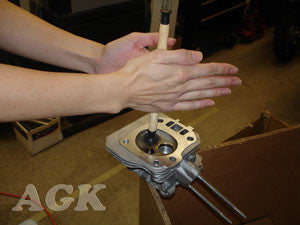Valve Lapping
| The seal between the valve and valve seat is crucial. If the valve is closed and the seal is not tight you will lose compression, thus losing power. This is a great procedure to use on all types of engines. When rebuilding an engine, lapping the valves can restore their seal to the valve seat. Lapping the valves on a new engine is a good idea too, especially on clone motors. A $150 clone engine is not always made to exacting tolerances so lapping the valves would ensure you get a good seal. | |
 |
Valve lapping tools can be purchased at your local auto parts store. Our kit came with two lapping tools. Each tool has two different size suction cups to accommodate different size valve heads. We also purchased a package of lapping compound at the auto parts store which included coarse and fine grit compound. |
 |
Begin by removing the cylinder head and valves. If you need help with this procedure, check our other how to articles.
Use your finger to apply lapping compound to the valve seat. Start with the course grit. Install the valve into the valve guide. Press the suction cup end of the lapping tool onto the head of the valve. |
 |
Spin the valve lapper tool handle between the palms of your hands until the two surfaces are smooth. Clean all of the compound off of the valve and valve seat. Repeat this process with fine grit compound. Spin the lapping tool until the gritty sound has gone away and the desired finish has been achieved. |
 |
When finished, you will have a shiny, smooth surface on both the valve and valve seat. After lapping both valves, you must thoroughly clean the lapping compound off of all the surfaces. |
